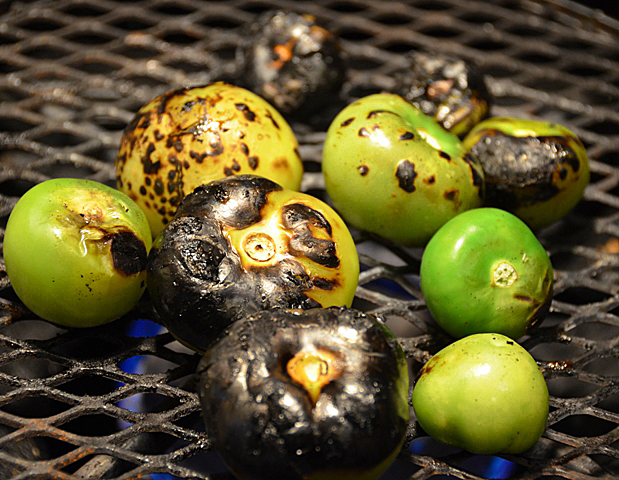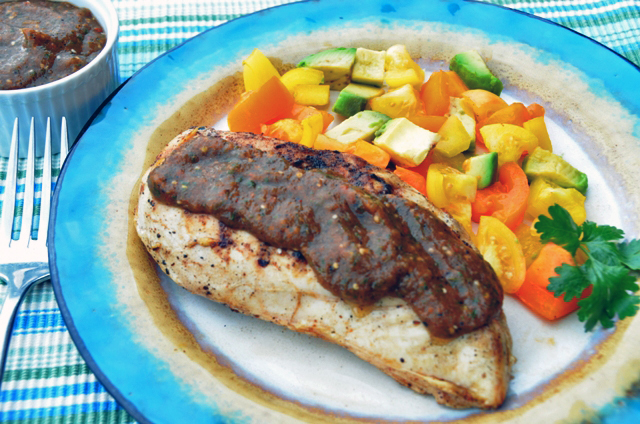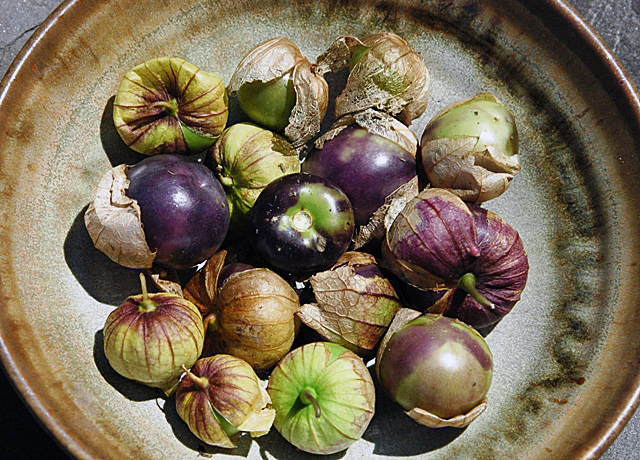Many cold winters ago as we were perusing the seed catalogs, Joe was going over the litany of our seed purchase list. Discovering something different, he asked, “Toe-mah-till-ohs?” “Uh sure, mm, okay.” I had never seen or heard of tomatillos before but was interested in the small green fruit. Were they like tomatoes? How do you know when they are ripe? Not having a large Mexican community in the area at that time my initial knowledge of real Mexican food (think not Chi Chis) came through the cookbooks of Rick Bayless and Diana Kennedy. I learned that it is pronounced, toh MAH tee yo, and tomatillos like tomatoes and eggplants are members of the nightshade family. Tomatillos are a prominent ingredient and bring the citrusy tang to salsa verde. I learned salsa verde was not just an alternate dip for tortilla chips, but a sauce to cook chicken or pork in. This knowledge didn’t bring me initial success as a gardener/harvester. I would examine the papery husks that resembled Chinese lanterns on the vine and not find much inside. So I would give up, some years we even skipped over growing them at all. Last year Joe found a seed source that had both green and purple tomatillos. With renewed determination I was going to harvest tomatillos. I learned that the tomatillo is ripe when the fruit fills out the outer layer and the papery skin starts to dry out.
Preparation is relatively easy, remove the outer husk and rinse off the sticky residue that coats the fruit. The fruit should be bright green, firm and tart. They can be eaten raw or boiled, but I feel they are best when charred or broiled. I like cooking my tomatillos on an asador, a round grate that sits on top of your gas burner or outdoor grill. Most often I use the asador on the gas cook top, moving the tomatillos around to blacken on all sides with tongs. They don’t look very pretty when you are done with them but the flavor is wonderful, smoky, sweet and a little citrusy all at the same time. I used the asador to cook all the elements of my salsa verde, the tomatillos, garlic, red onion and the peppers; Anaheim, Pasilla Bajio and a green Jalapeno for good measure. I put all the ingredients in a blender, pulsed on high for a few minutes and came out with a green chili sauce that I am liking more every day. I have topped pork,chicken and fish with it so far and I’m sure it would be just as good with a steak. This year I plan on freezing some tomatillos as well, a little chicken tomatillo soup in about a month will hit the spot.
Postscript : Once again, as with “Perfect Fish”, I have learned that the asador is no longer available for sale. One version (not mine) was part of a line that Rick Bayless was designing and bringing to market. Copco dropped that line when they sold the company. Bayless is in discussions with several manufacturers to bring back the stove-top roaster.
Salsa Verde
My own interpretation
Yield: about 2 1/2 cups
Ingredients
- 10-12 small to medium tomatillos, husked and washed
- 1 1″ thick slice of red onion
- 3 cloves garlic with the peel on
- 2-3 Anaheim chilis (mine were red)
- 1 Pasilla Bajio chili
- 1 Green Jalapeno chili
- 1t ground cumin
- 1t fresh lime juice
- 1T chopped cilantro (optional)
- Kosher salt and freshly ground pepper to taste
Directions
- Place stovetop asador over a gas flame, when the grill heats up (3-5 minutes) add as many tomatillos will fit comfortably stem side down. The stem side is flatter and the tomatillos will not roll around. Move tomatillos around the cooking surface to ensure even cooking. Using tongs, turn the tomatillos to the other side and cook until charred and completely softened, 4-5 minutes per side, depending on how intense your flame is. Move the cooked tomatillos to a sheet pan or bowl. Add more tomatillos, onion, garlic and peppers as you have room. The garlic will take only seconds, don’t allow it to burn.
- Let everything cool for about 10-15 minutes. Now for the “fun” part, peel, stem and seed the tomatillos, garlic and peppers. I find the best way to do this is in the kitchen sink with a large bowl and cold running water near by to keep the skins and seeds from sticking to your hands. It’s okay if some of the char remains, it adds a little character and flavor to the sauce.
- Place tomatillos, onion, garlic and peppers in the blender. I like to add a teaspoon or so of ground cumin and some fresh lime juice. Blend on high, occasionally scraping down the sides of the bowl to incorporate all the ingredients.
- Pour sauce into a bowl, season with kosher salt and freshly ground pepper to taste. I add a tablespoon of chopped cilantro at this point, but that is optional.
- Alternately the tomatillos, garlic, onion and peppers could be charred under a broiler or over an outdoor grill.

Tomatillos in various stages of charring 
Close up of tomatillo on asador. 
Chilis on asador 
Ready to peel 
Green chili sauce (salsa verde) over grilled chicken breast served with a salad of heirloom tomatoes, peppers and avocado.

